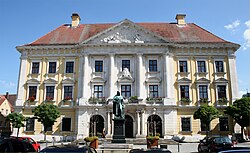Lauingen | |
|---|---|
 The town hall | |
Location of Lauingen within Dillingen district  | |
| Coordinates: 48°34′N 10°26′E / 48.567°N 10.433°E | |
| Country | Germany |
| State | Bavaria |
| Admin. region | Schwaben |
| District | Dillingen |
| Government | |
| • Mayor (2018–24) | Katja Müller[1] (CSU) |
| Area | |
| • Total | 44.39 km2 (17.14 sq mi) |
| Elevation | 439 m (1,440 ft) |
| Population (2023-12-31)[2] | |
| • Total | 11,445 |
| • Density | 260/km2 (670/sq mi) |
| Time zone | UTC+01:00 (CET) |
| • Summer (DST) | UTC+02:00 (CEST) |
| Postal codes | 89415 |
| Dialling codes | 09072 |
| Vehicle registration | DLG |
| Website | www.Lauingen.de |

Lauingen (Swabian: Lauinga) is a town in the district of Dillingen in Bavaria, Germany.[3] It is located on the left bank of the Danube, 5 km west of Dillingen, and 37 km northeast of Ulm.
In June 1800, the armies of the French First Republic, under command of Jean Victor Moreau, fought Habsburg regulars and Württemberg contingents, under the general command of Pál Kray. Kray had taken refuge in the fortress at Ulm; Moreau diverted his army to approach Ulm from the east. Kray had ordered preparation for the destruction of all the bridges across the Danube, including the one at Lauingen. A small group of French captured a foothold on the northern bank of the Danube by Grensheim, and Moreau's forces were able to move against the fortress on both sides of the river. At this battle, the culmination of the Danube Campaign of 1800, Moreau forced Kray to abandon Ulm and withdraw into eastern Bavaria.[4]
- ^ Liste der ersten Bürgermeister/Oberbürgermeister in kreisangehörigen Gemeinden, Bayerisches Landesamt für Statistik, accessed 19 July 2021.
- ^ Genesis Online-Datenbank des Bayerischen Landesamtes für Statistik Tabelle 12411-003r Fortschreibung des Bevölkerungsstandes: Gemeinden, Stichtag (Einwohnerzahlen auf Grundlage des Zensus 2011).
- ^ "Lauingen on German Culture".
- ^ "Höchstädt", History of the Wars of the French Revolution: Including Sketches of the Civil History of Great Britain and France, from the Revolutionary Movements, 1788, to the Restoration of a General Peace, 1815, Kuhl, France, 1820, p. 183.


